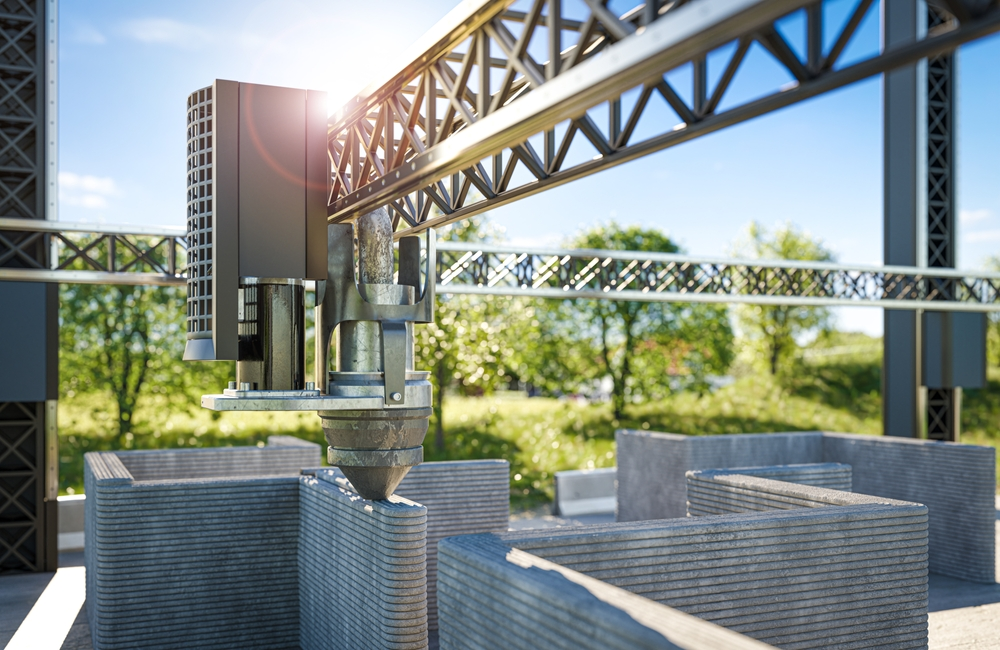Intro
When was the first 3D Printer invented? The first 3D printer patent was submitted to Denmark on July 12, 1967, by American graduate student Wyn Kelly Swainson. 3D printed construction technology has been advancing, reaching a point where it is now possible to construct buildings exceeding 1,000 square meters. In this content, I aim to introduce cases of construction using 3D printers and the trends in technological development in this field.
2 Types of 3D Concrete Printing Methods
The concrete used in 3D printing differs from conventional concrete in that it possesses a high point density and a pseudo-solid nature with minimal flowability. This characteristic allows it to maintain the shape coming out of the nozzle through extrusion, enabling the stacking of layers. Two representative types of 3D printers that implement this process are as follows.
1. Gantry Printer

The most popular type of 3D concrete printing robots are gantry robots, which are made up of a mobile gantry system with mixing and deposition equipment. These can be large-scale printers for printing full components or buildings, or they can be small lab models. Although these printers are usually only able to print vertical extrusions, they have the advantage of being quite stable and easily scalable for larger projects.
2. Robotic Arm
This type of printer is more suitable for printing complicated shapes due to its higher degree of freedom. However, its drawback lies in its limited range, making it most commonly used for small-scale applications.
Now, let's explore cases where 3D concrete printing has been applied in construction, in chronological order. Through this, we can observe the initial implementations and the current developed state.
2015 World's first 3D printed apartment building
In 2015, the Chinese company WinSun successfully constructed a 3D printed 5-story apartment building. Unlike contemporary method of 3D concrete printing, which is continuous construction without assembly, this building was constructed in an assembly form, where each component was 3D printed and then assembled. According to WinSun's claims, 3D printing construction can save between 30 and 60 percent of construction materials, reduce construction time by 50 to 70 percent, and cut labor costs by 50 up to even 80 percent. However, it is important to note that these claims lack supporting evidence, so they should be considered for reference only.
2016 World's first 3D printed Office building
The first 3D printed commercial building was achieved by Dubai Future Foundation. The construction of the 36.57 meters (120 feet) long building took only 17 days.The government of Dubai declared that 3D printing, which is more environmentally friendly, will be used in the upcoming construction. Dubai has announced plans to construct 25% of its new buildings with 3D printing by 2030.
2017 World’s largest 3D printed two-story building
The government of Dubai achieved another milestone for 3D printing in construction. The building spans 640 square meters and has a height of 9.5 meters. Apis Cor's robotic arm like-3D printer is used for the construction of this building.
2024 Europe's largest 3D printed building is completed
One of COBOD's 3D printers can build 4 square meters of wall per hour. That's how Europe's largest 3D printed building is fully constructed. Not only is the procedure quicker, but it also requires less labor and materials and is cleaner than traditional building sites. It’s three times faster than conventional building. The construction process started in March 2023. The building is 54 meters long, 11 meters wide, and 9 meters high.
Advantages of a 3D Printed House
As seen in the above examples, 3D printers have advantages such as reducing construction time, minimizing industrial waste, and offering flexibility in design. However, the widespread adoption of 3D printing technology is hindered by high initial costs. The expense of purchasing or renting a 3D printer can be very substantial.
I think we will see more and more construction of buildings with 3D printers. It is rapidly moving out of the experimental phase and into the commercial market. In order to house the projected 3 billion people who will require access to appropriate housing by 2030, the UN Habitat estimates that 96,000 new affordable homes must be built worldwide each day. Maybe 3D printer can be a solution.
References
First 3D-printing patent | Guinness World Records
EUROPE’S LARGEST 3D PRINTED BUILDING IS BEING CONSTRUCTED IN GERMANY | COBOD
How Europe's biggest 3D-printed building is being constructed | DW
Yes, that 3D-printed mansion is safe to live in | The Washington Post
※ If you click on the keywords below "Topics," you can view related contents.